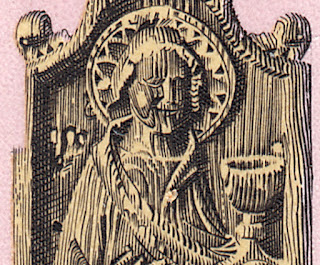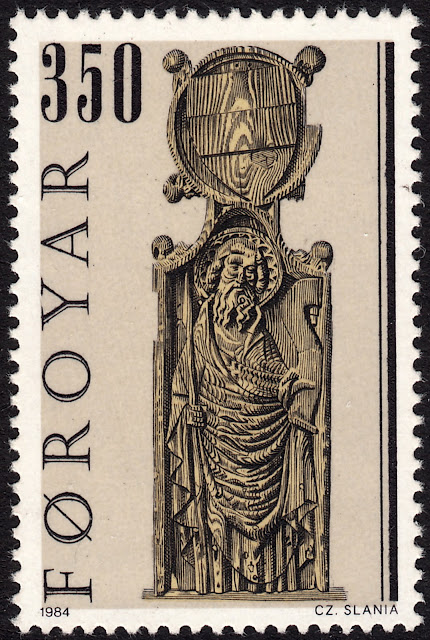More than a year has passed since I last visited the oldest functioning church in the Faroe Islands, a church which has a connection with the stamp engraving guru, Czeslaw Slania. That church is Saint Olav's, and its origins date to the 12th Century. The church was reconstructed in 1874. It is located in the village of Kirkjubøur on the island of Streymoy in the Faroe Islands.
So you might be asking yourself what is the connection between Czeslaw Slania and Saint Olav's? It all started back in medieval times when it was decided it would be nice to decorate the ends of the church pews of Saint Olav's with elaborate carvings. Pews are the long benches found in churches upon which parishioners sit. The ends, generally wooden, are often decorated. Below is an example of the beautifully carved pew ends that were housed in Saint Olav's, all of which are now located in the National Museum of the Faroe Islands. There were twelve of these marvellous pews in the church, each one representing an important Christian figure.
These pew ends are such fine pieces of art that the Faroe Islands Postal Authority decided to celebrate their beauty by featuring them on three sets of four stamps, issued between 1980 and 2001. Czeslaw Slania was picked to do the engravings. There were four stamps initially printed, and these were issued on 8 October 1980. Two subsequent sets of four were issued in 1984 and 2001. In this blog I will focus on the second set of four issued on 30 January 1984.
***
The first pew end carving this time around depicts St John. In this carving we see St John holding what I presume is the Holy Grail. At the Last Supper, John sat next to Jesus and leaned on him as a sign of support, so the Grail is a symbol of his loyalty to Christ. Above St John on the top portion of the pew, we find a shield, upon which are carved three crowns.
Taking a closer look at the face of St John, the irregularities and aging of the timber have been added by Slania, giving the design that extra touch of authenticity.
***
The second stamp in the series depicts the carved image of St Jacob. St Jacob is often depicted holding a staff. On the shield above St Jacob we find a pair of crossed keys, which basically represent the keys to the Kingdom of Heaven.
***
The third stamp in the series depicts the carved image of St Thomas. St Thomas' attribute is a spear, which we can see in his right hand. And upon the shield above him is a crossbeam, representing the cross of St Thomas.
***
The final stamp in the series depicts the carved image of St Jude, also known as Thaddeus. St Jude's attribute is a club, which he is wielding in his left hand. The shield above St Jude is adorned with the Toulouse Cross and halo.
***
I am yet again amazed at the stunning true-wood appearance of the pews in these stamps. The detail Slania has captured in each and every one of these pew ends is exquisite. Bravo, Mr Slania! I have just one final comment. In my blog post dealing with the 1980 issue in this series, I mentioned that I had only one criticism. I have the same criticism this time around also. It is purely an aesthetic one. I just really don't like the background colours chosen for these stamps. But that's just my opinion.
Until next time...







This carvings that you have shared very well are very unique. And this information is valuable to me.
ReplyDeleteThank you so much.
Pincodezone